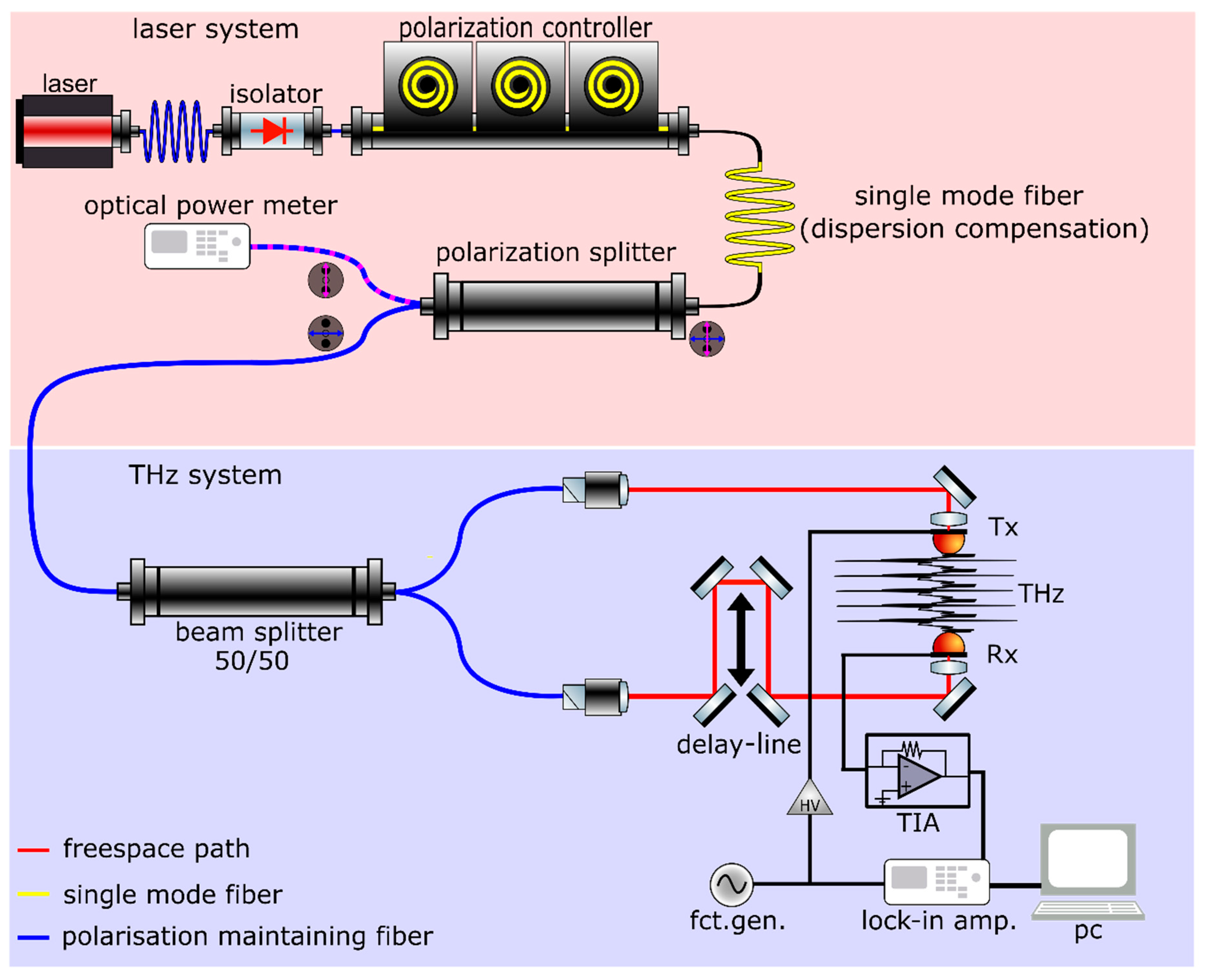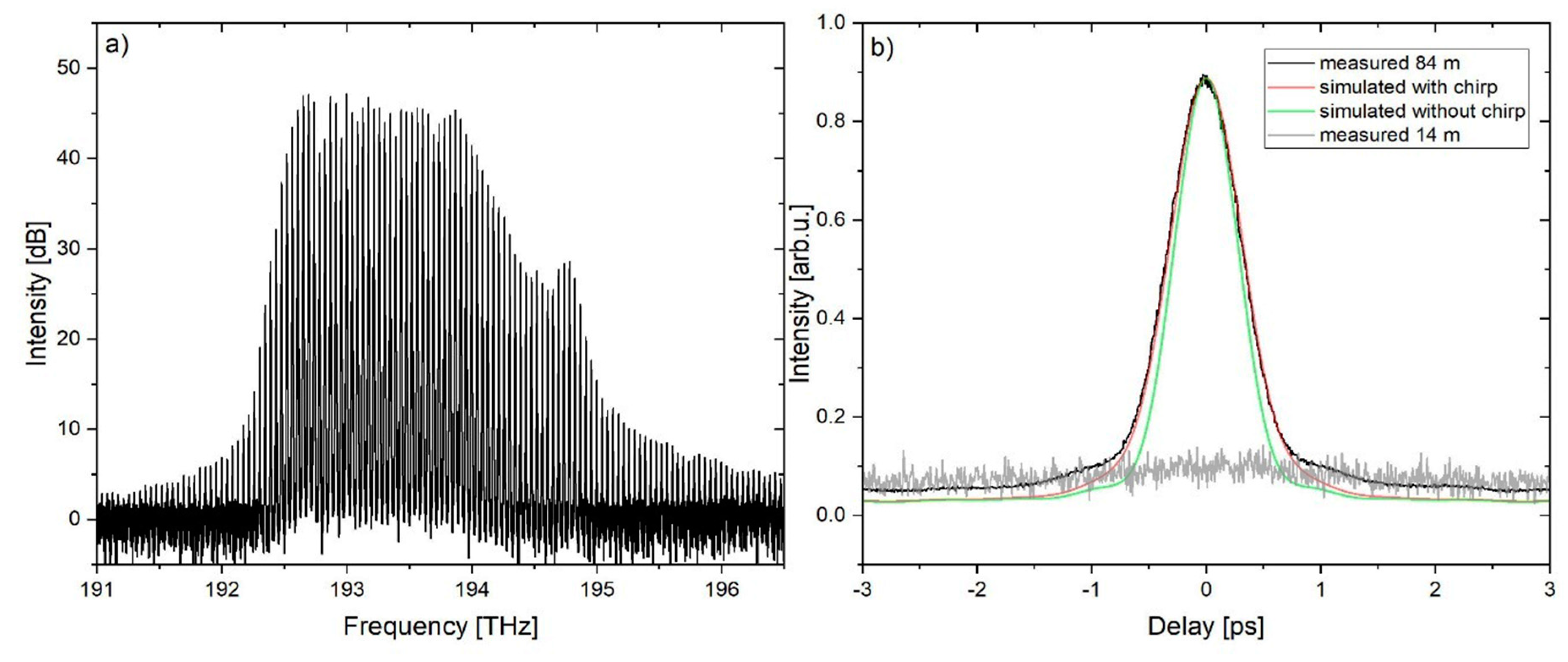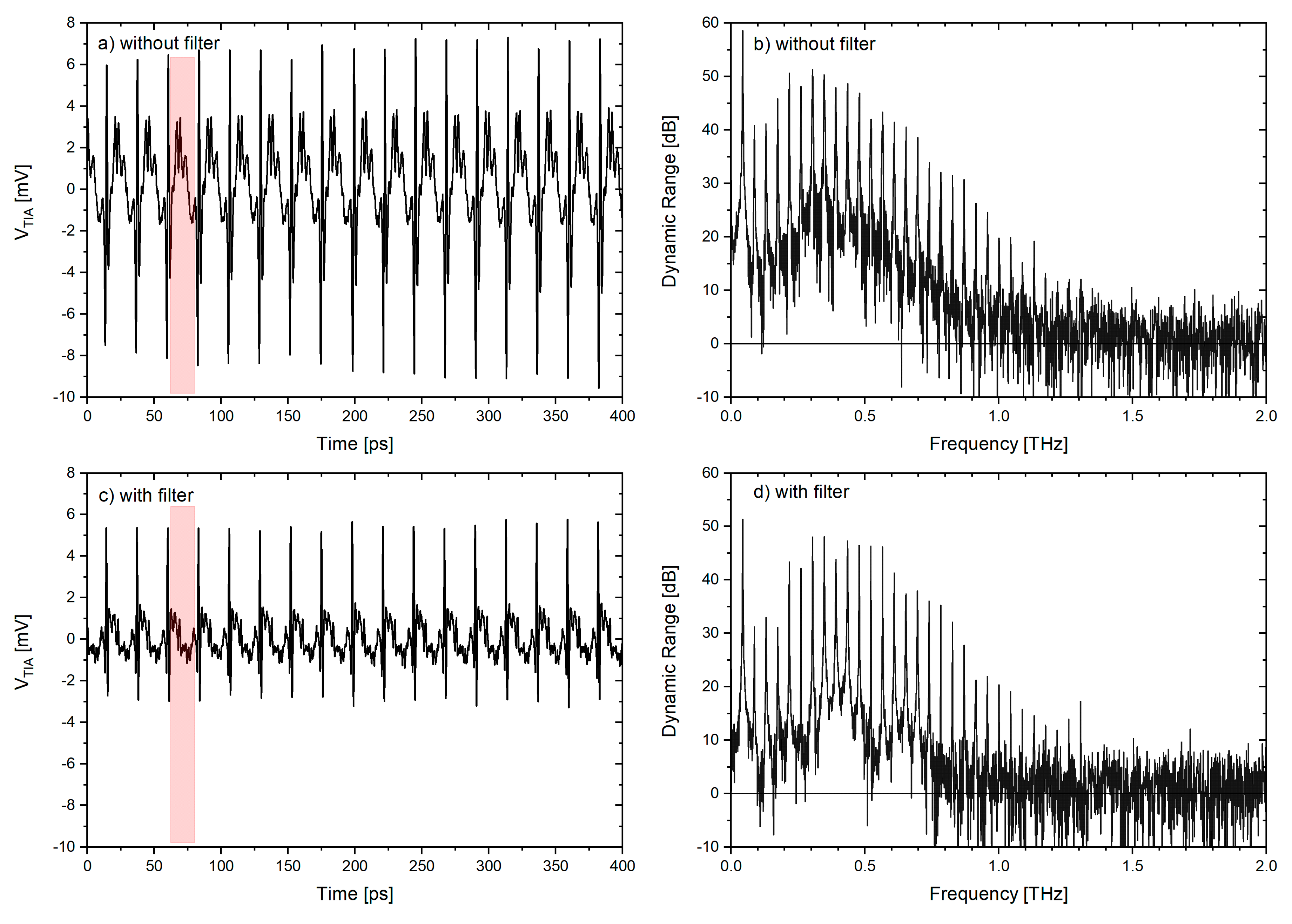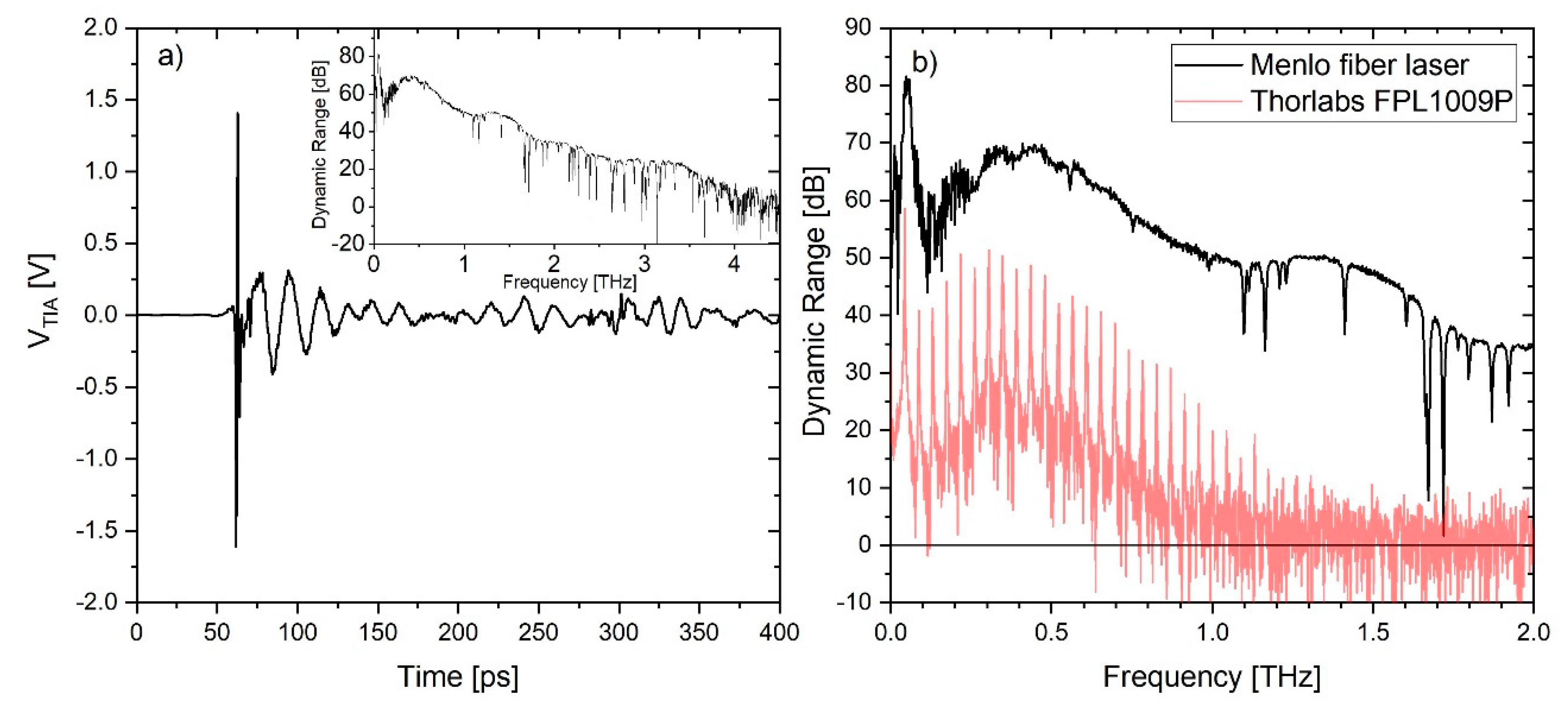Terahertz Time-Domain Spectroscopy Based on Commercially Available 1550 nm Fabry–Perot Laser Diode and ErAs:In(Al)GaAs Photoconductors
Abstract
:1. Introduction
2. Experimental Setup
2.1. Laser System
2.2. THz System
2.3. Reference Laser System
3. Results
3.1. Optical Characterization
3.2. THz Results
3.3. Comparison with Reference Laser System
4. Conclusions
Author Contributions
Acknowledgments
Conflicts of Interest
References
- Van Exter, M.; Fattinger, C.; Grischkowsky, D. Terahertz time-domain spectroscopy of water vapor. Opt. Lett. 1989, 14, 1128. [Google Scholar] [CrossRef]
- Jepsen, P.U.; Cooke, D.G.; Koch, M. Terahertz spectroscopy and imaging—Modern techniques and applications. Laser Photon. Rev. 2011, 5, 124–166. [Google Scholar] [CrossRef]
- Hu, B.B.; Nuss, M.C. Imaging with terahertz waves. Opt. Lett. 1995, 20, 1716. [Google Scholar] [CrossRef]
- Sartorius, B.; Roehle, H.; Künzel, H.; Böttcher, J.; Schlak, M.; Stanze, D.; Venghaus, H.; Schell, M. All-fiber terahertz time-domain spectrometer operating at 1.5 μm telecom wavelengths. Opt. Express 2008, 16, 9565. [Google Scholar] [CrossRef] [PubMed]
- Palka, N.; Panowicz, R.; Ospald, F.; Beigang, R. 3D Non-destructive Imaging of Punctures in Polyethylene Composite Armor by THz Time Domain Spectroscopy. J. Infrared Millim. Terahertz Waves 2015, 36, 770–788. [Google Scholar] [CrossRef] [Green Version]
- Kusano, M. Non-destructive evaluation by terahertz spectroscopy for penetration of acid solutions into epoxy resin. Express Polym. Lett. 2016, 10, 941–949. [Google Scholar] [CrossRef]
- Abdul-Munaim, A.M.; Aller, M.M.; Preu, S.; Watson, D.G. Discriminating gasoline fuel contamination in engine oil by terahertz time-domain spectroscopy. Tribol. Int. 2018, 119, 123–130. [Google Scholar] [CrossRef]
- Redo-Sanchez, A.; Salvatella, G.; Galceran, R.; Roldós, E.; García-Reguero, J.-A.; Castellari, M.; Tejada, J. Assessment of terahertz spectroscopy to detect antibiotic residues in food and feed matrices. Analyst 2011, 136, 1733. [Google Scholar] [CrossRef] [PubMed]
- Gowen, A.A.; O’Sullivan, C.; O’Donnell, C.P. Terahertz time domain spectroscopy and imaging: Emerging techniques for food process monitoring and quality control. Trends Food Sci. Technol. 2012, 25, 40–46. [Google Scholar] [CrossRef] [Green Version]
- Mathanker, S.K.; Weckler, P.R.; Wang, N. Terahertz (THz) Applications in Food and Agriculture: A Review. Trans. ASABE 2013, 56, 1213–1226. [Google Scholar]
- Stübling, E.-M.; Rehn, A.; Siebrecht, T.; Bauckhage, Y.; Öhrström, L.; Eppenberger, P.; Balzer, J.C.; Rühli, F.; Koch, M. Application of a robotic THz imaging system for sub-surface analysis of ancient human remains. Sci. Rep. 2019, 9, 3390. [Google Scholar] [CrossRef] [PubMed]
- Cosentino, A. Terahertz and Cultural Heritage Science: Examination of Art and Archaeology. Technologies 2016, 4, 6. [Google Scholar] [CrossRef]
- Cacciari, I.; Siano, S. Use of THz Reflectometry for Roughness Estimations of Archeological Metal Surfaces. J. Infrared Millimeter. Terahertz Waves 2017, 38, 503–517. [Google Scholar] [CrossRef]
- Hochrein, T. Markets, Availability, Notice, and Technical Performance of Terahertz Systems: Historic Development, Present, and Trends. J. Infrared Millimeter. Terahertz Waves 2015, 36, 235–254. [Google Scholar] [CrossRef]
- Vasil’ev, P.P. Ultrashort pulse generation in diode lasers. Opt. Quantum Electron. 1992, 24, 801–824. [Google Scholar] [CrossRef]
- Balzer, J.C.; Pilny, R.H.; Dopke, B.; Klehr, A.; Erbert, G.; Trankle, G.; Brenner, C.; Hofmann, M.R. Passively Mode-Locked Diode Laser With Optimized Dispersion Management. IEEE J. Sel. Top. Quantum Electron. 2015, 21, 16–23. [Google Scholar] [CrossRef]
- Delfyett, P.J.; Florez, L.; Stoffel, N.; Gmitter, T.; Andreadakis, N.; Silberberg, Y.; Heritage, J.P.; Alphonse, G.A. High-power ultrafast laser diodes. IEEE J. Quantum Electron. 1992, 28, 2203–2219. [Google Scholar] [CrossRef]
- Tani, M.; Matsuura, S.; Sakai, K.; Hangyo, M. Multiple-frequency generation of sub-terahertz radiation by multimode LD excitation of photoconductive antenna. IEEE Microw. Guid. Wave Lett. 1997, 7, 282–284. [Google Scholar] [CrossRef]
- Tani, M.; Morikawa, O.; Matsuura, S.; Hangyo, M. Generation of terahertz radiation by photomixing with dual- and multiple-mode lasers. Semicond. Sci. Technol. 2005, 20, S151–S163. [Google Scholar] [CrossRef]
- Scheller, M.; Koch, M. Terahertz quasi time domain spectroscopy. Opt. Express 2009, 17, 17723. [Google Scholar] [CrossRef]
- Brenner, C.; Hofmann, M.; Scheller, M.; Shakfa, M.K.; Koch, M.; Mayorga, I.C.; Klehr, A.; Erbert, G.; Tränkle, G. Compact diode-laser-based system for continuous-wave and quasi-time-domain terahertz spectroscopy. Opt. Lett. 2010, 35, 3859. [Google Scholar] [CrossRef] [PubMed]
- Kohlhaas, R.B.; Rehn, A.; Nellen, S.; Koch, M.; Schell, M.; Dietz, R.J.B.; Balzer, J.C. Terahertz quasi time-domain spectroscopy based on telecom technology for 1550 nm. Opt. Express 2017, 25, 12851. [Google Scholar] [CrossRef] [PubMed]
- Molter, D.; Kolano, M.; von Freymann, G. Terahertz cross-correlation spectroscopy driven by incoherent light from a superluminescent diode. Opt. Express 2019, 27, 12659. [Google Scholar] [CrossRef] [PubMed]
- Merghem, K.; Busch, S.F.; Lelarge, F.; Koch, M.; Ramdane, A.; Balzer, J.C. Terahertz Time-Domain Spectroscopy System Driven by a Monolithic Semiconductor Laser. J. Infrared Millim. Terahertz Waves 2017, 38, 958–962. [Google Scholar] [CrossRef]
- Rosales, R.; Murdoch, S.G.; Watts, R.T.; Merghem, K.; Martinez, A.; Lelarge, F.; Accard, A.; Barry, L.P.; Ramdane, A. High performance mode locking characteristics of single section quantum dash lasers. Opt. Express 2012, 20, 8649. [Google Scholar] [CrossRef] [PubMed]
- Calò, C.; Schmeckebier, H.; Merghem, K.; Rosales, R.; Lelarge, F.; Martinez, A.; Bimberg, D.; Ramdane, A. Frequency-resolved optical gating measurements of sub-ps pulses from InAs/InP quantum dash based mode-locked lasers. In Proceedings of the 2013 International Conference on Indium Phosphide and Related Materials (IPRM), Kobe, Japan, 19–23 May 2013; Volume 22, pp. 10835–10840. [Google Scholar]
- Nandi, U.; Norman, J.C.; Gossard, A.C.; Lu, H.; Preu, S. 1550-nm Driven ErAs: In(Al)GaAs Photoconductor-Based Terahertz Time Domain System with 6.5 THz Bandwidth. J. Infrared Millim. Terahertz Waves 2018, 39, 340–348. [Google Scholar] [CrossRef]
- Duill, S.P.O.; Murdoch, S.G.; Watts, R.T.; Rosales, R.; Ramdane, A.; Landais, P.; Barry, L.P. Simple dispersion estimate for single-section quantum-dash and quantum-dot mode-locked laser diodes. Opt. Lett. 2016, 41, 5676. [Google Scholar] [CrossRef] [PubMed]
- Gente, R.; Busch, S.F.; Stubling, E.-M.; Schneider, L.M.; Hirschmann, C.B.; Balzer, J.C.; Koch, M. Quality Control of Sugar Beet Seeds With THz Time-Domain Spectroscopy. IEEE Trans. Terahertz Sci. Technol. 2016, 6, 1–3. [Google Scholar] [CrossRef]
- Gente, R.; Rehn, A.; Probst, T.; Stübling, E.M.; Camus, E.C.; Covarrubias, A.A.; Balzer, J.C.; Koch, M. Outdoor Measurements of Leaf Water Content Using THz Quasi Time-Domain Spectroscopy. J. Infrared Millim. Terahertz Waves 2018, 39, 943–948. [Google Scholar] [CrossRef]
- Rehn, A.; Mikerov, M.; Preu, S.; Koch, M.; Balzer, J.C. Enhancing the performance of THz quasi time-domain spectroscopy systems by low duty cycle laser operation. Opt. Express 2018, 26, 32758. [Google Scholar] [CrossRef]




© 2019 by the authors. Licensee MDPI, Basel, Switzerland. This article is an open access article distributed under the terms and conditions of the Creative Commons Attribution (CC BY) license (http://creativecommons.org/licenses/by/4.0/).
Share and Cite
Tybussek, K.-H.; Kolpatzeck, K.; Faridi, F.; Preu, S.; Balzer, J.C. Terahertz Time-Domain Spectroscopy Based on Commercially Available 1550 nm Fabry–Perot Laser Diode and ErAs:In(Al)GaAs Photoconductors. Appl. Sci. 2019, 9, 2704. https://doi.org/10.3390/app9132704
Tybussek K-H, Kolpatzeck K, Faridi F, Preu S, Balzer JC. Terahertz Time-Domain Spectroscopy Based on Commercially Available 1550 nm Fabry–Perot Laser Diode and ErAs:In(Al)GaAs Photoconductors. Applied Sciences. 2019; 9(13):2704. https://doi.org/10.3390/app9132704
Chicago/Turabian StyleTybussek, Kai-Henning, Kevin Kolpatzeck, Fahd Faridi, Sascha Preu, and Jan C. Balzer. 2019. "Terahertz Time-Domain Spectroscopy Based on Commercially Available 1550 nm Fabry–Perot Laser Diode and ErAs:In(Al)GaAs Photoconductors" Applied Sciences 9, no. 13: 2704. https://doi.org/10.3390/app9132704







